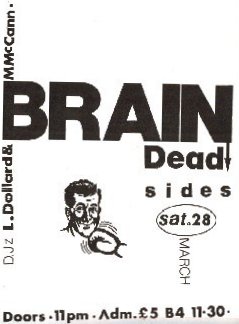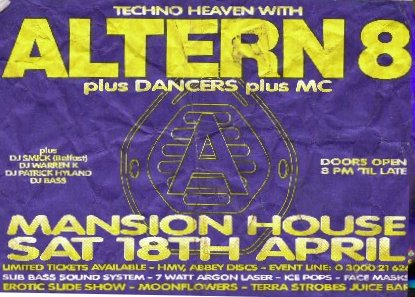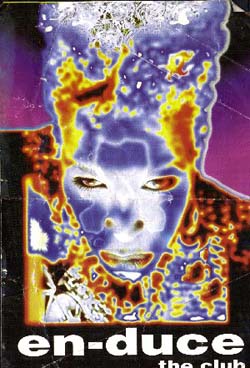The History of Dublin Clubbing
My personal experience of the early days of Dublin Raving and Clubbing
In 2000, I was asked to write a "History of Dublin Clubbing" article for a tiny palm-sized fanzine called DUBfly. The space I had to write this in was tiny. So I had to leave loads out. This is certainly no definitive history... it was nothing more than my own personal experience of a very brief time period... with a bad title, so apologies if I've missed out you or your favourite club, rave or DJ. I'm not going to rewrite it - but I have changed the title to reflect all the omissions.
 1988 - heralded as year zero in clubland. In the UK maybe, but over here our
summer of love kicked off in true style some two years later. Before the
barrage of genre splicing in today's electronic music, the few styles
we had then, fitted neatly in to two scenes, Raving and Clubbing. The
first true dance club in Dublin was Sides, residing in Dame Lane, owned
by John Murphy and run by Ken Kelly. In true form to the history of club
culture, Sides was originally a gay club that opened in the mid '80s.
As the indie music policy began to take a back seat to more dance orientated
sounds, resident DJ's Martin McCann and Liam Fitz were eventually joined
by Johnny Moy, Liam Dollard, Billy Scurry, Dave Hales, Dave Moore and
Joe McHugh. By '91 the club really took off attracting hoards of loyal
regulars and dedicated house lovers.
1988 - heralded as year zero in clubland. In the UK maybe, but over here our
summer of love kicked off in true style some two years later. Before the
barrage of genre splicing in today's electronic music, the few styles
we had then, fitted neatly in to two scenes, Raving and Clubbing. The
first true dance club in Dublin was Sides, residing in Dame Lane, owned
by John Murphy and run by Ken Kelly. In true form to the history of club
culture, Sides was originally a gay club that opened in the mid '80s.
As the indie music policy began to take a back seat to more dance orientated
sounds, resident DJ's Martin McCann and Liam Fitz were eventually joined
by Johnny Moy, Liam Dollard, Billy Scurry, Dave Hales, Dave Moore and
Joe McHugh. By '91 the club really took off attracting hoards of loyal
regulars and dedicated house lovers.
At the other end of the spectrum and just up the road, was the Olympic Ballroom, a very popular and infamous venue for dancers in the 50's and 60's. Owner Liam Ryan didn't need much coaxing to realise the potential merit of refilling the Olympic with dancers of a new generation. The first rave was held there in April 1990, the night was called Orbit and Dave Hales, Johnny Moy, Mark Kavanagh and Niall Comiskey took control of the ones and twos that night. Soon after, Marcus O'Neill took over to run a night called Dance Crazy which ran for six weeks before passing the reins back to the owner; Ryan got Mark Kavanagh back on board, who remained as head resident until a series of raids in �94, which led to the venue losing its license.

Even two years after the biggest culture explosion had occurred, the Irish media still hadn't really cottoned onto the fact that it was going on in their own country and continued to copy scare stories from the UK tabloids. It wasn't until promoters started staging events in the Mansion House that the press really sat up and paid attention. They made sure to cover one particular night when TD Tony Gregory and a select commitee lined the balconies of the Mansion House to determine just how drug fuelled these raves were. They gave it the thumbs up. Unknown to them at the time the very reason the night was bereft of any trouble was the full-scale use of Ecstacy rather then the naively presumed lack of. The Mansion house staged big extravaganza's rather then weekly regulars, featuring state of the art sound and light systems, and bands such as Shades of Rhythm, Altern8 and the Ragga twins. UK legends like Jumping Jack frost, Grooverider and Tin Tin joined Dublin regulars like the Banana boys, Brenda Morrisey, The Latin Wolf and members of the DFC, (Dublin funk Collective) Speedy D, DJ Noel and DJ Bass.
What was it like then? Firstly, it's fairly important to paint a picture of the dance scenes status in society back then. It hadn't much representation in the media, no TV programmes, no books, no club listings in evening papers and a far cry away from any full-length movies. Undocumented, unknown, underground. So to walk into a crowd of 1000+ nutters dancing like no ones watching, with lazers flying overhead, music from the next century and strangers instantly becoming best friends was an exhilarating slap in the face, like walking into another dimension, let in on one big secret. Even buzzing about town on a Saturday afternoon and catching the eye of someone similarly clad would warrant a knowing smile. This is where the real magic lay, what created such a gargantuan atmosphere, everyone on the same level, going through that initial honeymoon phase together.
Just before the ballroom closed down, a new three level, all night club called the Asylum opened and that's exactly what it was. It bore witness to the first batch of E casualties, burnt out ravers desperately chasing that initial rush, the dawning realisation that nothing this good lasts forever painted across their jaded faces. However, a fresh batch always arrived to fill the void and this new crowd kept the balance in check. The Asylum also welcomed in a new batch of DJ's. Dilly, the then Northern Ireland mixing champ, took residency in the Asylum along with Dublin's Ed case, Warren K and Pressure. The clubs eventual downfall was its very open display as a drug haven and was soon shut down.
The Temple of Sound opened soon after and was in complete contrast to the Asylum. Along with G1, another legendary club in Phibsborough and the later to come Kitchen, it had a full bar. By then many clubbers re-embraced alcohol as the drug of choice, laughing off the days of chastising the demon liquid. Manager Ken Kane gave a new home to Scurry, Moy, house maestro Mark Dixon and introduced Stephen Mullhall and Paddy Gallagher as well as top class international guests. Like Sides, after a couple of years the Temple sadly changed management and in turn, the DJ's and music policy, before eventually closing down altogether.
Taking this more professional standard to the next level John Reynolds opened the POD. With an award winning interior design and re-incarnations of club 54 bouncers on the door the original ethos was somewhat lost. Granted it boasted a pristine sound system but was strictly for the ears of the beautiful people. In 1996 the POD's sister club the Red Box opened next door which thankfully had a slightly more relaxed approach and a more varied music policy.
 Two clubs that worked away in the background, slowly building from the
ground up were McGonagles and UFO. McGonagles started off with a
mixture of indie, acidhouse and popdance, and then under the banner of the Voodoo
club, changed to upfront Hip Hop, House and Rare Grooves, with guests DJ's that included
Norman Jay, Gilles Peterson, Coldcut, Soul II Soul, Jay Strongman, Dave Dorrell and Mike Pickering.
Later again the club became En-duce giving residence to the Banana Boys (Mark Cee
and Dave McDonnell). The venue eventually got a facelift and thrived for
a few years as The System.
Two clubs that worked away in the background, slowly building from the
ground up were McGonagles and UFO. McGonagles started off with a
mixture of indie, acidhouse and popdance, and then under the banner of the Voodoo
club, changed to upfront Hip Hop, House and Rare Grooves, with guests DJ's that included
Norman Jay, Gilles Peterson, Coldcut, Soul II Soul, Jay Strongman, Dave Dorrell and Mike Pickering.
Later again the club became En-duce giving residence to the Banana Boys (Mark Cee
and Dave McDonnell). The venue eventually got a facelift and thrived for
a few years as The System.
UFO started off as a small affair in the UCD bar in 1989 and moved to the Rock Garden in Temple Bar three years later. After a brief stint in Powers hotel, the brainchild of François Pittion and Mick Heaney finally moved to Columbia Mills (on Sir John Rogerson's Quay) in 1994 where it gained a religiously loyal crowd, one key to atmospheres of such electric status. Columbia Mills also played host to the Beat club, the early incantations of Influx boys Paul Davis and Johnny Moy, with guests such as Andy Weatherall, Darren Emerson and regular Dublin visitor David Holmes (then known as Homer). The Beat club was like a re-incarnation of early sides, nights put on in style with cutting edge sounds attracting devout music lovers and was a recipe for success.
Today, Influx, the Redbox and the Kitchen are still thriving and people like D1 and Ultramack* continue to push the original idea of quality music in a friendly atmosphere, by music lovers for music lovers. Almost ten years later now, clubs are still opening and closing and no matter how big or small, all face the constant battle against Ireland's archaic authorities. A major cheers to all who've fought the battle and apologies if I couldn't fit you into this space, you know who you are.
*And Bassbin! Can't believe I forgot Bassbin in the final shoutout of crews who were killing it at time of writing.